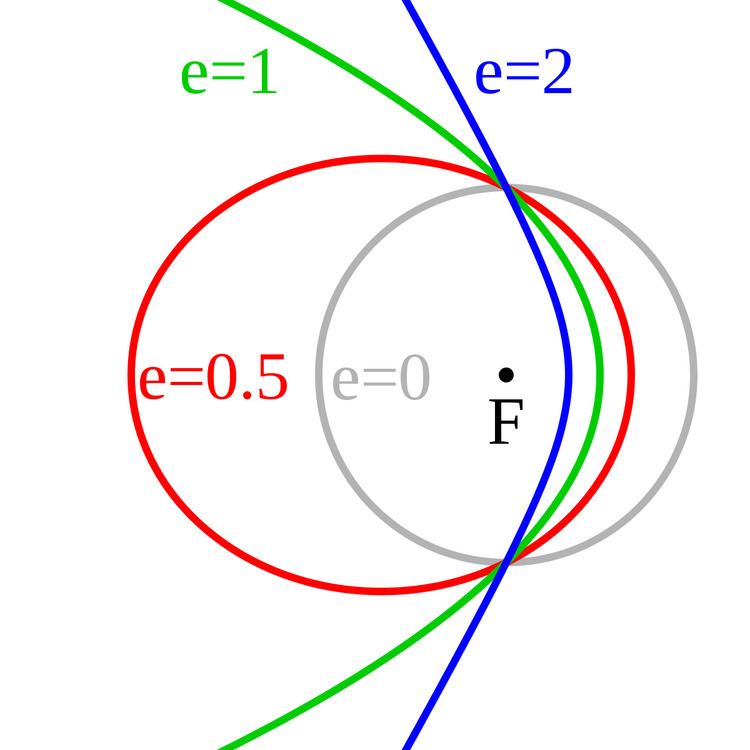 | ||
In astrodynamics or celestial mechanics, a hyperbolic trajectory is the trajectory of any object around a central body with more than enough speed to escape the central object's gravitational pull. The name derives from the fact that according to Newtonian theory such an orbit has the shape of a hyperbola. In more technical terms this can be expressed by the condition that the orbital eccentricity is greater than one.
Contents
- Parameters describing a Hyperbolic trajectory
- Semi major axis energy and hyperbolic excess velocity
- Eccentricity and angle between approach and departure
- Impact Parameter and the distance of closest approach
- Position
- Flight path angle
- Velocity
- Radial hyperbolic trajectory
- Relativistic two body problem
- References
Under standard assumptions a body traveling along this trajectory will coast to infinity, arriving there with hyperbolic excess velocity relative to the central body. Similarly to parabolic trajectory all hyperbolic trajectories are also escape trajectories. The specific energy of a hyperbolic trajectory orbit is positive.
Planetary flybys, used for gravitational slingshots, can be described within the planet's sphere of influence using hyperbolic trajectories.
Parameters describing a Hyperbolic trajectory
Like an elliptical orbit, a hyperbolic trajectory for a given system can be defined (ignoring orientation) by its semi major axis and the eccentricity . However, with a hyperbolic orbit other parameters may more useful in understanding a body's motion. The following table lists the main parameters describing the path of body following a hyperbolic trajectory around another under standard assumptions and the formula connecting them.
Semi-major axis, energy and hyperbolic excess velocity
The semi major axis (
The semi major axis is directly linked to the specific orbital energy (
where:
Note that the total energy is positive in the case of a hyperbolic trajectory (whereas it is negative for an elliptical orbit).
Eccentricity and angle between approach and departure
With a hyperbolic trajectory the orbital eccentricity (
The angle between the direction of periapsis and an asymptote from the central body is the true anomaly as distance tends to infinity (
Impact Parameter and the distance of closest approach
The impact parameter is the distance by which a body, if it continued on an unperturbed path, would miss the central body at its closest approach. With bodies experiencing gravitational forces and following hyperbolic trajectories it is equal to the semi-minor axis of the hyperbola.
In the situation of a spacecraft or comet approaching a planet, the impact parameter and excess velocity will be known accurately. If the central body is known the trajectory can now be found, including how close the approaching body will be at periapsis. If this is less than planet's radius an impact should be expected. The distance of closest approach, or periapse distance, is given by:
So with a comet approaching Earth (effective radius ~6400km) with an velocity of 12.5 km/s (the approximate minimum approach speed of a body coming from the outer solar system) is to avoid a collision with Earth, the impact parameter will need to be at least 8600km, or 34% more than the Earth's radius. A body approaching Jupiter (radius 70000km) from the outer solar system with a speed of 5.5 km/h, will need the impact parameter to be at least 770,000km or 11 times Jupiter radius to avoid collision.
If the mass of central body is not known then its standard gravitational parameter and hence is mass can be determined by the deflection of the smaller body together with the impact parameter and approach speed. As, typically, all these variables can be determined accurately, a spacecraft flyby will provide a good estimate of mass.
Position
In a hyperbolic trajectory the true anomaly
The relation between the true anomaly θ and the eccentric anomaly E is:
The eccentric anomaly E is related to the mean anomaly M by Kepler's equation:
The mean anomaly is proportional to time
Flight path angle
The flight path angle (φ) is the angle between the direction of velocity and the perpendicular to the radial direction, so it is zero at periapsis and tends to 90 degrees at infinity.
Velocity
Under standard assumptions the orbital speed (
where:
Under standard assumptions, at any position in the orbit the following relation holds for orbital velocity (
Note that this means that a relatively small extra delta-v above that needed to accelerate to the escape speed results in a relatively large speed at infinity. For example, at a place where escape speed is 11.2 km/s, the addition of 0.4 km/s yields a hyperbolic excess speed of 3.02 km/s.
This is an example of the Oberth effect. The converse is also true - a body does not need to be slowed by much compared to its hyperbolic excess speed (e.g. by atmospheric drag near periapsis) for velocity to fall below escape velocity and so for the body to be captured.
Radial hyperbolic trajectory
A radial hyperbolic trajectory is a non-periodic trajectory on a straight line where the relative speed of the two objects always exceeds the escape velocity. There are two cases: the bodies move away from each other or towards each other. This is a hyperbolic orbit with semi-minor axis = 0 and eccentricity = 1. Although the eccentricity is 1 this is not a parabolic orbit.
Relativistic two-body problem
In context of the two-body problem in general relativity, trajectories of objects with enough energy to escape the gravitational pull of the other, no longer are shaped like an hyperbola. Nonetheless, the term "hyperbolic trajectory" is still used to describe orbits of this type.
